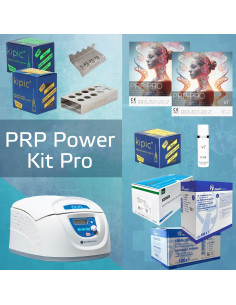PRF
100399
The PRP Power Kit Pro contains all the essential components for successfully carrying out PRP therapies.
This PRP set consists of:
1x DUO centrifuge
2x PRP tubes | Vi PRP-Pro PU 10 pcs.
1x KIPIC® needle 25G x 42mm, PU 100 pcs.
1x KIPIC® Mesotherapy Needle 30G 4mm | PU 100 pcs.
1x KIPIC® Mesotherapy needle 32Gx4mm | PU 100 pcs.
1x Mediware disposable...
immediately available
€2,416.73
PRP tube holder / test tube stand
100314
PRP tube holder stainless steel/brushed is a high quality tube holder/container designed to hold and store PRP tubes. It is made of brushed stainless steel and has a smooth surface. The PRP tube holder holds only the lower part of the tube, which makes it easier to work with. Capacity 10 tubes.
immediately available
€27.50
PRP/CGF tubes - 10 pieces | without anticoagulants
100104
Density Platelet Gel PRP/CGF is the simplest and most efficient way to obtain and process platelet-rich plasma (PRP) from blood. The tubes contain no separating gel and have no anticoagulants, making them a safe and effective way to treat injuries, pain and other conditions.
Here are some advantages of Density Platelets Gel PRP/CGF tubes:
Easy and...
immediately available
€122.00
Syringe holder - stainless steel/brushed
100315
A syringe holder is an indispensable instrument, e.g. when performing a PRP treatment. It enables a hygienic and clear storage of the syringes during the treatment. Made of brushed steel, it ensures robust and durable use. Capacity 4 syringes.
immediately available
€27.00









